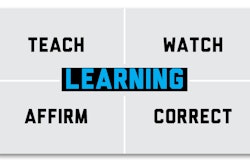
Since the recession, many companies have brought training back in-house; however, we will see more selective outsourcing around specific training processes, topics and technologies. Speed is essential when it comes to training employees. How fast can you get relevant content developed and available to learners? Can your company produce top performing employees before your competitors? Resources such as articles, press releases, white papers and competitive research reports, in addition to short Web-based training modules, will see increased demand to make it easier for learners to consume and apply content. While social media is picking up speed, how we can use it in the context of training is continuing to be explored.
Training Budgets and Expenditures
Eighty-one percent of respondents prepared a yearly budget for training activities, which is slightly lower from FMI’s 2007 results (82%). However, we found that 73% of companies have decreased their training budget because of the “Great Recession.” This is expected to increase slowly as the market continues to recover.
Hours of Training
The number of hours spent training senior executives, project managers, field managers and trade/craft personnel ranged from 31 to 76 hours per year. This is above the average published in ASTD’s 2010 State of the Industry Report, which for Best Awards program (BEST) companies reported an average of 32 hours per employee. Seventy-six percent of those surveyed this year, an increase from previous years, indicated that they determined training and development needs for their employees through performance appraisal discussions. We found that employees may not always be aware in which areas they need further development, making this method of determining individual training a positive trend.
Measuring Training Results
Companies should measure their effectiveness in producing the learning outcomes specified when the training was planned and indicate where improvements are necessary to make the training even more effective the next time it is needed. Forty-one percent of respondents indicated that they were monitoring reaction to the training programs through program evaluations. Thirty-six percent of respondents are evaluating the effectiveness of training through the assessment of new skills and knowledge gained during the training program. Unfortunately, it is much harder to measure whether training has an impact on organizational performance (in any industry), as proven by our results indicating that 40% do not track ROI for training. The good news is that 43% of those surveyed are looking at changes in job performance before and after training.
Talent Development Practices
When asked what practices were used in the past year to increase employee performance and development, 83% of the respondents said they conducted annual performance reviews with their employees. Nearly two-thirds of those respondents indicated using supervisory ratings as the type of performance evaluations their employees receive, and more than 50% are using informal meetings between employee and his/her supervisor or mentor. Many supervisors find it helpful to hold regular informal meetings throughout the year to stay better-informed and to keep the lines of communication open.
Interestingly enough, formal training conducted in-house and by outside vendors made the list of top-five ways companies plan to increase employee performance and development. These two did not make the list in previous years, as many companies took a break from formal training programs due to the economy.
Employees at more than 50% of the companies that responded to the survey are creating personal development plans. The personal development planning process is an extension of the performance review process in that it allows the manager and the employee to identify and advance towards reasonable developmental goals necessary for his or her personal and professional growth.
A remarkable 50% of companies who responded to this year’s survey plan to offer Web-based training over the next year to increase employee performance and development. Web-based learning has become increasingly popular over the past few years as companies begin to realize the benefits, including reduced travel expenses, less time away from the job and just-in-time training. Unfortunately, there are still obstacles to effectively delivering Web-based training in the construction industry.
*General contractors made up 71% of the respondents, followed by construction managers (14%) and engineering (6%). Forty-four percent of the responses were from firms with revenues between $100 million and $499.9 million, which is very consistent from our past surveys. Also consistent with previous surveys were the number of employees at season peak, with almost half of the respondents employing 100-499 workers. Contrary to previous years, more than half of the respondents (56%) were presidents, chief executive officers or vice presidents.



















